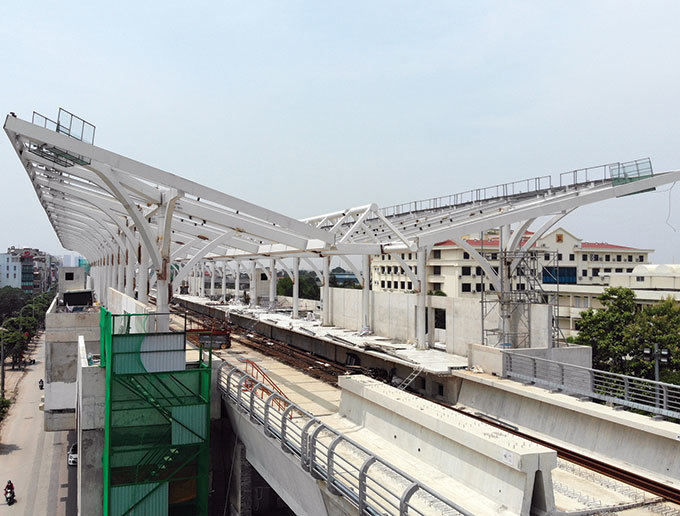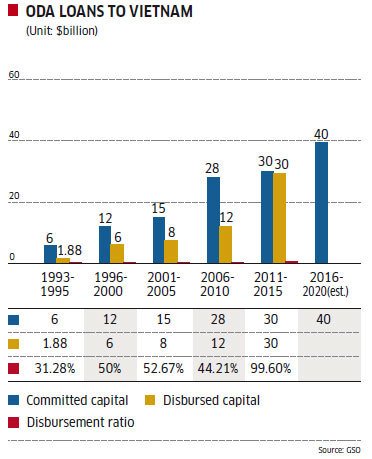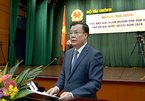
Official development assistance (ODA) and concessional loans to Vietnam are expected to fall and eventually come to an end within the next five years, resulting in a shortage of preferential long-term credit resources for investment.
This requires the country develop a new approach to management and use, as ODA is considered one of the major resources for economic development, Deputy Prime Minister Vuong Dinh Hue told a Ministry of Planning and Investment (MPI) conference in mid-July.
Unexpected results
MPI figures reveal that estimated disbursement of ODA in the first half of this year stood at VND4.1 trillion ($176.2 million), or 6.9 per cent of the National Assembly’s plan and 12.7 per cent of the plan assigned by the Prime Minister.
Eight of 59 localities had a disbursement rate of over 30 per cent, eleven ministries and departments disbursed less than 30 per cent, and 28 localities disbursed no ODA.
By 2018, Vietnam had received a total of $80 billion in ODA and concessional loans, making it one of the largest recipients of this funding type in the world.
Some 80 per cent was provided by the six major development banks. Reports from JICA, ADB, and the World Bank presented during the ODA National Steering Committee meeting chaired by Deputy Prime Minister Pham Binh Minh in June showed that their Vietnam projects have been implemented better than those in other countries, with a high rate of completion and set targets reached.
However, the disbursement of ODA and loans slowed, down from a high 23.1 per cent in 2014 to 11.2 per cent in 2018.
The figure is lower than the average global rates of the six donors. Of committed capital for Vietnam in 2018 alone, up to $16.9 billion is yet to be disbursed.
Notably, construction of five urban railway projects in Hanoi and Ho Chi Minh City funded by ODA loans have been sluggish, despite seeing increases of a combined VND80 trillion ($3.44 billion) in total capital.
Minister of Planning and Investment Nguyen Chi Dung told a Q&A session chaired by the National Assembly Standing Committee in mid-August that the projects are the first of their kind to be executed in Vietnam and domestic stakeholders all lacked both experience and capacity.
“We were unable to foresee all the processes of these projects, so the total investment capital had to be adjusted from approval to implementation,” he added.
The Ben Thanh - Suoi Tien metro line section, the first in Ho Chi Minh City, saw total capital increase by VND30 trillion ($1.29 billion) to VND47 trillion ($2.02 billion).
Total investment in the second metro line, meanwhile, was adjusted from VND26 trillion ($1.11 billion) to VND47 trillion ($2.02 billion). The Cat Linh - Ha Dong metro section in Hanoi has undergone additional capital adjustments totaling some VND50 trillion ($2.15 billion).
The number of projects that had to adjust investment procedures in the first half of 2019 was 26, according to the Department of Debt Management and External Finance at the Ministry of Finance (MoF), and the allocation of funds for disbursement at these projects remains stagnant. In order to quickly sign off on projects, many ministries and localities have committed to allocating sufficient counterpart funds for implementation.
Many projects, however, have not been allocated or seen arrangements made for sufficient counterpart funds, leading to slow implementation. In many cases, although projects are arranged with adequate capital plans, implementation has been tardy because project preparation has exhibited many shortcomings.
Issues relating to project design consultancy and site clearance and resettlement are often the main reasons behind slow implementation.
The slow fund allocation and implementation are the primary concerns of project owners and donors. “ADB-financed projects deliver substantial positive development results and perform well regarding technical and financial management performance indicators,” Mr. Eric Sidgwick ADB Country Director, told VET.
“They also follow national laws and international best practices to protect the environment, promote gender equality, and properly safeguard against negative social impacts. However, the lack of procurement readiness and often slow approval of annual ODA budgets by government oversight agencies affects disbursement, which can delay intended results.”
“We have observed that the disbursement ratio has deteriorated recently,” said Ms. Takahashi Junko, Senior Representative at the JICA Vietnam Office.
“The disbursement ratio, which is the ratio between actual disbursement and the total remaining balance for pipeline projects, fell to 13.6 per cent in Japanese fiscal year 2018, while it was around 20 per cent in the last ten years and even close to 30 per cent in 2015, at its peak. This fiscal year, progress is a mere 13 per cent against our annual disbursement plan, despite the fact that we are reaching the halfway point of the fiscal year.”
JICA has a number of ongoing projects without any disbursement seen this year, and one-third of their portfolio has been dealing with a shortage of budget appropriation.
“Some projects finally received additional budget allocations in July, but the actual disbursement takes place after another one or two months, pending administration procedures,” Ms. Junko said.
“We only expect disbursement to catch up after September, leaving a mere three months in the calendar year. This is critical.”
Slow disbursement means delays in project completion and thus delivery of development impacts, she went on.
Many contractual obligations are also breached due to late payments, and this deteriorates the reputation for doing business in Vietnam among international contractors, despite the efforts of the government to gain full acknowledgement of its market economy by other countries.
Synchronized regulations

The ADB, in coordination with other development partners, works closely with the government to address these bottlenecks by providing project readiness financing, supporting electronic procurement and online disbursement, and providing timely and accurate annual disbursement estimates to support the ODA budget planning process.
According to Mr. Sidgwick, through regular engagement with the government’s ODA steering committee, the ADB and other development partners have provided recommendations in three broad areas.
Firstly, the government needs to set clearer and consistent roles and responsibilities for the various agencies involved in ODA management and to streamline approval steps, appropriately delegating authority to enable faster decisions.
Secondly, it should accelerate project start up by enabling more advance procurement, including making better use of project readiness financing or counterpart funds to prepare detailed engineering designs in parallel with project appraisal.
Thirdly, there should be more flexibility to quickly include new projects or adjust a proposed project’s scope in medium-term investment plans, and annual ODA and counterpart budget allocations should be approved and available every January.
Professor Nguyen Quang Thai, President of the Vietnam Development Research Institute (VIDERI), told VET that there needs to be unity in regulations between Vietnam and foreign donors to resolve disbursement-related issues.
The legal framework should also be quickly completed to ensure transparency in using ODA loans, as the current method of ODA management is no longer suitable with the Law on Public Investment and the policies of international donors, as Vietnam has become a middle-income country.
The time of low-interest capital sources is over and Vietnam is shifting to an era of fewer preferential loans. That means that costs for ODA-funded projects are increasing, so the use of loans needs to be efficient, according to local economist Dr. Le Dang Doanh.
“Vietnam needs to encourage private investment in public-private partnerships instead of using ODA loans,” he believes. “Major private Vietnamese groups should be able to join projects to boost implementation.”
According to Ms. Junko, it seems that the Vietnamese Government is hastily shifting its policy to seek private financing despite ODA terms and conditions offered by some bilateral donors, including JICA, remaining quite attractive.
A more carefully balanced and gradual shift between ODA and private financing is necessary. “The country should reassess its strategy for the utilization of ODA,” she said.
“In order for Vietnam to avoid the middle-income trap, attracting FDI and fully preparing for an aging society in the coming decades, addressing the right development needs and designing suitable interventions by the public are critically important. We hope such things can be improved in the next term.” VN Economic Times
Nghi Do

ODA for agricultural development nears $2 billion in 20 years
Vietnam has carried out 23 agricultural projects using official development assistance (ODA) worth over 1.96 billion USD, said an official.

Red tape results in low ODA disbursement in Vietnam: ADB
Vietnam’s average disbursement rate is much lower than that of other recipients of the Asian Development Bank’s ODA loans, largely due to cumbersome and time-consuming procedures, said Eric Sidgwick, ADB country director for Vietnam.

Minister: ODA disbursement at alarming pace
Disbursement of official development assistance (ODA) hit over VND1.6 trillion in the first five months of this year.
 Vietnam is striving towards boosting the disbursement and use of ODA and concessional loans as both have become issues in recent times.
Vietnam is striving towards boosting the disbursement and use of ODA and concessional loans as both have become issues in recent times.